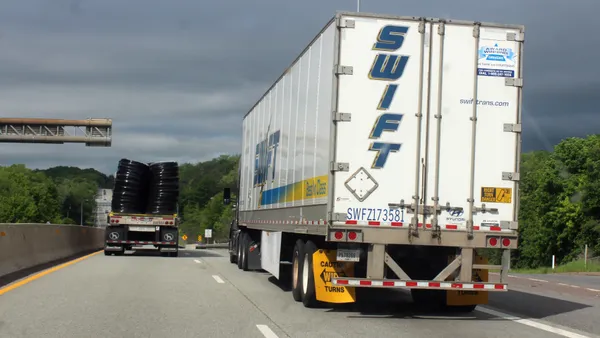Gatik is doubling down on autonomous trucks for the middle mile, aiming to mass produce AVs in 2027. Aurora plans to go fully autonomous in Q2 2025 for its Dallas-to-Houston launch lane.
As AVs take to the roads, the trucking industry has a key question: how to insure these vehicles.
Timothy Good, president of Good's Insurance Agency, said large trucking fleets are starting to prepare by studying and gathering as much data as possible on AVs. But plenty of questions remain unanswered, like whether premiums will go up or down, how risk will be assessed, and who or what is to blame in a crash.
“It’s a gray area,” said Todd Spencer, president of the Owner-Operator Independent Drivers Association. “There are lots and lots of unknowns.”
Risk: The big unknown
Insurance premiums are typically tied to perceived risk. The greater the perception of risk, the higher the premium.
In recent years, “truck insurance rates have been going up dramatically,” Spencer said.
Part of the reason is nuclear verdicts, in which jury awards can be more than $10 million. In Q4 2023, some truck insurance premiums rose 29% over Q3.
How premiums will change with the adoption of autonomous trucks is unknown. Jeremy Vrchota, CEO of Cota Systems, expects premiums initially to go up because of autonomous vehicle technology’s high cost and complexity.
But he doesn't believe that will be the case long term. In fact, autonomous truck adoption “is likely to lead to lower insurance premiums in the long run due to reduced human error and fewer accidents,” Vrchota said in an email.
In a driverless system, risk shifts from the driver to tech providers and manufacturers, Vrchota said. Insurance companies will need to create new models for liability based on that fact.
The risk picture could also be more complicated. When safety regulators investigate a crash, they often discover multiple factors as the cause. The same will likely be the case with autonomous trucks, Spencer said.
“We’ve had vehicles with various states of automation for quite a while, and they crash,” Spencer said. “But what really happened? Was it a single component, or a combination of components? Generally, we won’t know.”
Rael Morris, VP of growth initiatives at Lytx, gave the hypothetical example of a collision in which the autonomous systems functioned correctly, but old tires caused the crash. In that scenario, “who is liable? How does one ascertain what factors directly contributed to the collision?” he said via email.
Another risk factor with insuring autonomous trucks is cybersecurity. Good said federal agencies have conducted test scenarios in which they hired hackers. Those hackers were able to break into autonomous software and control functions such as braking and accelerating.
“The automation has not been proven to be 100% reliable,” Good said.
In Aurora’s latest annual report, the autonomous vehicle company noted its “insurance coverage for cyber-attacks may not be sufficient to cover all the losses we may experience as a result of a cyber incident, and any cyber incident may result in an increase in our costs for insurance or insurance not being available to us on economically feasible terms, or at all. Insurers may also deny us coverage as to any future claim.”
Aurora did not respond when asked how autonomous vehicles will affect insurance premiums.
Gatik, Kodiak and Waymo declined to comment on the effects their autonomous vehicles would have on insurance, and how they're working with fleets and insurance providers.
The insurance challenge
Good said the ultimate effect of AVs on insurance premiums is unknown, and he doesn’t anticipate fully driverless vehicles on the road for another 20 years.
Morris noted the challenge of writing insurance policies without years of data upon which to base pricing premiums.
“They will have little to no history to base their analysis on; they have very little data to work with, such as the frequency and severity of claims for autonomous vehicles, much less commercial trucks,” Morris said.
The trucking industry and its insurance providers face a lot of uncertainty related to insuring AVs. Figuring it out won’t be simple or straightforward.
“I think these are the issues that will delay the introduction of driverless autonomous vehicles,” Morris said. “Not the technology, but the legal, regulatory and insurance ecosystems that will need to be developed to support the technology.”














